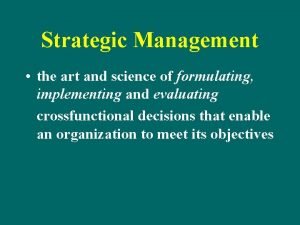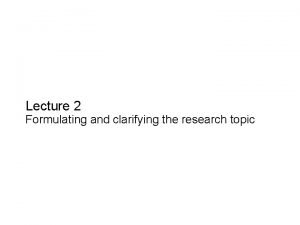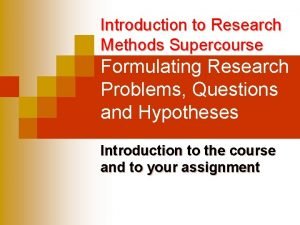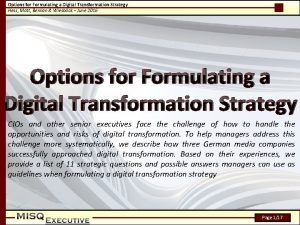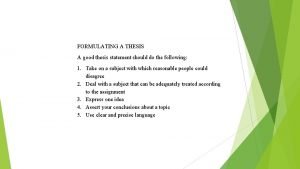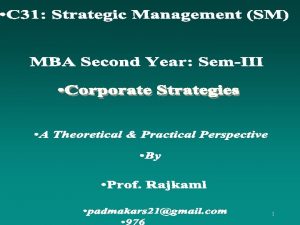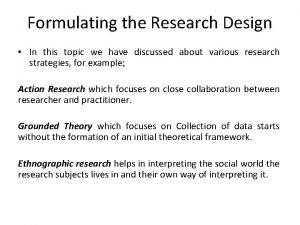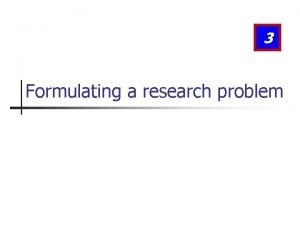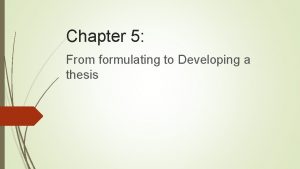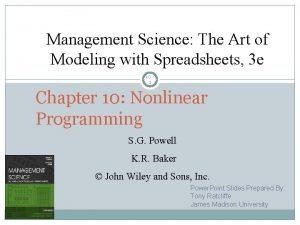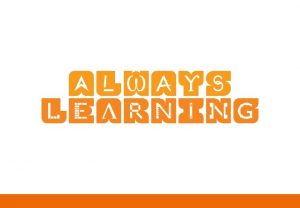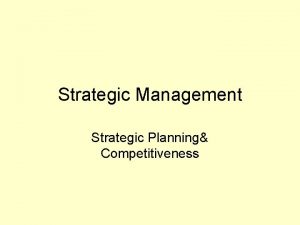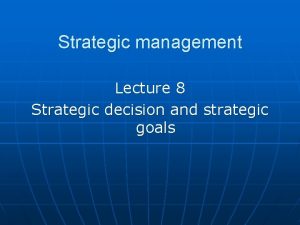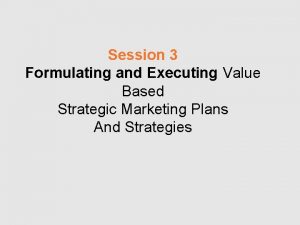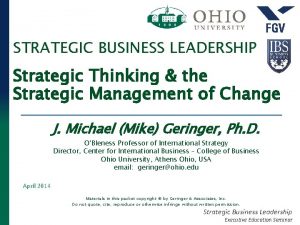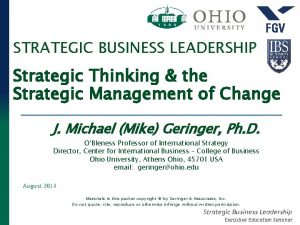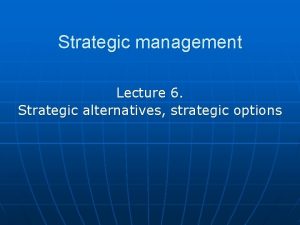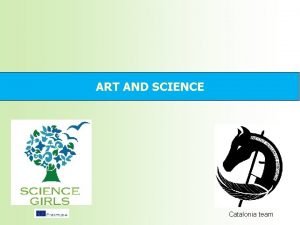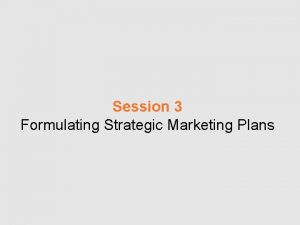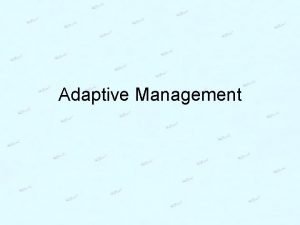Strategic Management the art and science of formulating





























- Slides: 29

Strategic Management • the art and science of formulating, implementing and evaluating crossfunctional decisions that enable an organization to meet its objectives

Tasks of Strategic Management Develop Strategic Vision and Mission Revise? Set Objectives Revise? Craft Strategy to Achieve Objectives Revise? Implement Strategy Revise? Evaluate, Review, Correct Revise?

Benefits of Strategic Management • Proactive approach to future – initiate and influence, rather than respond to activities – allows identification, prioritization, and exploitation of opportunities

Benefits of Strategic Management • Process more important than document – Communication – More informed decisions – Empowerment – Improved coordination and control of activities – Decisions support established objectives

Benefits of Strategic Management • Provides basis for identifying and rationalizing need for change – Less resistance to change • Provides rationale for allocating resources

Strategic Vision • Road map to future of company – Direction it is headed – Business position it intends to stake out – Capabilities it plans to develop • Unique to a company • Guides decision making • Shapes strategy

TASK I: Develop a Business Mission • Defines organization’s reason for being • Statement of purpose – distinguishes organization from all others • Provides basis for generating/screening strategic options

A Good Mission Statement • Defines what organization is and what it aspires to be – What needs will we satisfy? – Whose needs will we satisfy? – How customers’ needs will be satisfied?

A Good Mission Statement • Defines organization’s scope of activities • Broad enough to allow growth – allows generation of alternative objectives and strategies – provides useful criteria for selecting among alternatives

A Good Mission Statement • Simple and concise • Inspiring, motivating – Creates emotional bond between organization and employees • Provides unity of direction – Creates sense of shared expectations

Desirable Elements of a Mission Statement • • • Customers Products or services Markets Technology Concern for survival, growth, and profitability

Desirable Elements of a Mission Statement • • Philosophy Self-concept Concern for public image Concern for employees

TASK II: Setting Objectives • Objectives--specific performance targets – Yardsticks for tracking performance – Indicate strategic intent to stake out a particular business position • Financial or strategic • Long range or short range

Setting Objectives • Challenging but achievable in order to avoid – complacency – drift – internal confusion over where to focus resources – satisfaction with status quo

Strategy • A plan for achieving objectives – (game plan) • How the organization’s business will be conducted • How objectives will be achieved

Levels of strategy • • Corporate Business Functional Operating

TASK III: Crafting a Strategy • An ongoing (evolutionary) process • Done within context of internal and external situation

Crafting a Strategy • Strategy must “fit” with other aspects of the organization – capabilities – reward structure – policies and procedures – organizational culture

Strategic Plan • Integrated collection of strategies • Vertically and crossfunctionally coordinated • Specifies where organization is headed and how it plans to achieve targeted goals

Strategic Plan • Comprised of first 3 Tasks of Strategic Management – Define business/establish mission – Set performance objectives – Craft a strategy • Created within context of internal and external situation

Task IV: Implementation • Build an organization capable of carrying out strategy • Allocate ample resources to strategy critical activities • Establish strategy supportive policies and procedures • Institute Best Practices and mechanisms for continuous improvement

Implementation • Install support systems that allow personnel to carry out their strategic roles effectively • Tie rewards/incentives to performance objectives and good strategy execution • Strategy supportive work environment and corporate culture • Exercise strategic leadership

TASK V: Evaluation/Feedback • Continuously monitor performance • Monitor changes in environment • Initiate corrective adjustments as needed

Some general observations • These 5 tasks do not occur sequentially or independently • These tasks are not done in isolation from other managerial responsibilities

General observations • These tasks make erratic demands on a manager’s time • Effective execution of a sound current strategy is often more desirable than excessively changing strategy

Factors shaping the Choice of Strategy Societal, political, regulatory, community citizenship considerations Industry attractiveness; changing industry and competitive conditions Company opportunities and threats Company’s strategic situation Company strengths, weaknesses and competitive capabilities Personal ambitions, business philosophies, and ethics of key executives Shared values and company culture S t r a t e g y O p t i o n s

Industry and Competitive Analysis • Dominant economic traits • Existing competition and competitive forces • Driving forces in industry • Strongest /weakest companies • Key Success Factors for the industry • Overall industry attractiveness

Company Situation Analysis • Identify current mission, objectives, strategy • How well is current strategy working? • SWOT • Financial analysis • Strength of competitive position • Strategic issues/problems

Strategic analysis leads to good strategic choices Industry and competitive conditions Best Strategy Fits co. situation? Realistic strategic options Company situation analysis Lead to Comp. Adv. ? Improve Co. Performance?
 The art and science of formulating
The art and science of formulating Strategic management and strategic competitiveness
Strategic management and strategic competitiveness Analysing the 6 strategic options megxit
Analysing the 6 strategic options megxit Examples of research topics and their objectives
Examples of research topics and their objectives Formulating and clarifying the research topic
Formulating and clarifying the research topic Formulating and clarifying the research topic
Formulating and clarifying the research topic Formulating and clarifying the research topic
Formulating and clarifying the research topic Formulating and clarifying the research topic
Formulating and clarifying the research topic Formulating and clarifying the research topic
Formulating and clarifying the research topic What's your favourite lesson
What's your favourite lesson Puppy dog ploy strategy
Puppy dog ploy strategy Options for formulating a digital transformation strategy.
Options for formulating a digital transformation strategy. Formulating a thesis
Formulating a thesis Community action plan
Community action plan Formulating corporate level strategy
Formulating corporate level strategy Formulating a research design
Formulating a research design Claim/thesis definition
Claim/thesis definition Research questions and objectives
Research questions and objectives Unit 1 materials formulating matter
Unit 1 materials formulating matter What is the main objective in formulating the imdg code?
What is the main objective in formulating the imdg code? Working thesis
Working thesis Formulating research methodology
Formulating research methodology Formulating solutions
Formulating solutions Data collection plan research proposal
Data collection plan research proposal Difference between administration and management
Difference between administration and management Management science the art of modeling with spreadsheets
Management science the art of modeling with spreadsheets Strategic fit vs strategic intent
Strategic fit vs strategic intent Architecture is the art and science of designing buildings
Architecture is the art and science of designing buildings Hát kết hợp bộ gõ cơ thể
Hát kết hợp bộ gõ cơ thể Slidetodoc
Slidetodoc
